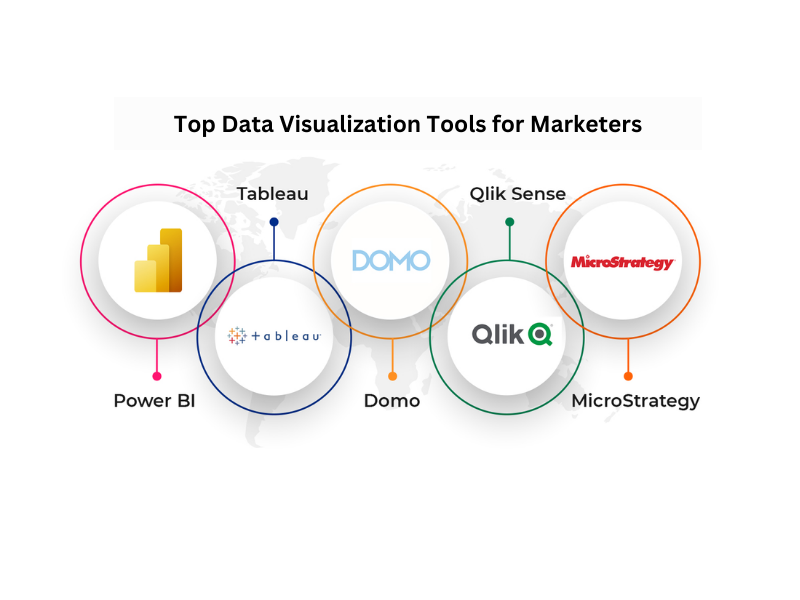Introduction
In today’s fast-paced digital landscape, where competition is fierce, data has become the backbone of every successful marketing strategy. Gone are the days when gut feelings and guesswork drove decision-making. Today, the most successful marketers rely on data to guide their actions, fine-tune their campaigns, and ultimately, achieve better results.
But why is data so crucial in digital marketing? Simply put, it provides a clear, objective view of what’s working and what isn’t. It allows marketers to understand their audience, measure the impact of their efforts, and make informed decisions that can significantly boost return on investment (ROI). However, the vast amount of data available can be overwhelming. Without the right tools and techniques to analyze this data, even the most experienced marketers can find themselves lost in a sea of numbers.
This blog post will explore the top tools and techniques that can help you not only make sense of your marketing data but also use it to drive more effective, data-driven decisions. Whether you’re new to data analysis or looking to refine your existing strategies, this guide will provide you with the insights you need to take your digital marketing to the next level.
The Importance of Data Analysis in Digital Marketing
Data analysis is not just a buzzword in digital marketing; it’s the cornerstone of a successful strategy. As businesses increasingly shift their focus online, the ability to understand and leverage data has become essential for staying competitive. But why exactly is data analysis so crucial?

Informed Decision-Making:
At its core, data analysis empowers marketers to make informed decisions rather than relying on intuition. By examining data from various sources—whether it’s website traffic, social media engagement, or email open rates—you can identify patterns and trends that reveal what resonates with your audience. This insight allows you to adjust your strategies in real-time, optimizing campaigns for maximum impact.
Enhanced ROI:
One of the most significant benefits of data-driven marketing is its potential to increase return on investment (ROI). By analyzing metrics such as cost per acquisition (CPA) and customer lifetime value (CLV), you can allocate your budget more effectively, focusing on channels and tactics that deliver the highest returns. This not only maximizes your marketing spend but also ensures that your efforts are aligned with business objectives.
Understanding Customer Behavior:
Data analysis provides a deep dive into customer behavior, helping you understand what drives their actions. For instance, by analyzing click-through rates (CTR) and conversion paths, you can identify the most effective touchpoints in your sales funnel. This understanding allows you to tailor your messaging and offers to meet customer needs more precisely, leading to higher engagement and conversion rates.
Competitive Advantage:
In a crowded digital marketplace, staying ahead of the competition requires a keen understanding of industry trends and consumer preferences. Data analysis gives you that edge. By keeping a close eye on competitor activity and market shifts, you can anticipate changes and adapt your strategies accordingly. This proactive approach not only helps you maintain your market position but also opens up opportunities for innovation and growth.
Continuous Improvement:
The digital landscape is constantly evolving, and what worked yesterday may not work tomorrow. Data analysis enables a cycle of continuous improvement, where you can test, learn, and refine your strategies based on real-time feedback. Whether it’s through A/B testing or performance tracking, this iterative process ensures that your marketing efforts are always optimized for success.
In summary, data analysis is the key to unlocking the full potential of your digital marketing efforts. It transforms raw data into actionable insights, guiding your decisions and driving measurable results. As we move forward, we’ll explore the tools and techniques that can help you harness this power and make data-driven marketing a reality for your business.
Overview of Essential Marketing Analytics Tools
The right tools can make all the difference when it comes to analyzing marketing data effectively. With an abundance of analytics platforms available, choosing the right ones can be overwhelming. However, understanding the strengths of each tool can help you make an informed decision that aligns with your marketing goals. Below, we’ll explore some of the most essential marketing analytics tools that can elevate your data analysis efforts.

Google Analytics
Why It’s Essential: Google Analytics is often considered the gold standard for website analytics. It offers an in-depth view of your website’s performance, tracking metrics such as user behavior, traffic sources, and conversion rates. Whether you’re running a small business or managing a large-scale digital presence, Google Analytics provides the insights needed to optimize your online strategies.
Key Features:
- Audience Reports: Understand the demographics, interests, and geographic location of your visitors.
- Acquisition Reports: See where your traffic is coming from—be it search engines, social media, or direct visits.
- Behavior Reports: Analyze what visitors do on your site, including which pages they visit and how long they stay.
- Conversion Tracking: Measure how well your site fulfills your objectives, such as sales, sign-ups, or downloads.
Best Practices:
- Audience Reports: Understand the demographics, interests, and geographic location of your visitors.
- Acquisition Reports: See where your traffic is coming from—be it search engines, social media, or direct visits.
- Behavior Reports: Analyze what visitors do on your site, including which pages they visit and how long they stay.
- Conversion Tracking: Measure how well your site fulfills your objectives, such as sales, sign-ups, or downloads.
- Set up goals and funnels to track specific user actions.
- Use segmentation to analyze different audience groups.
- Regularly review your reports to spot trends and make data-driven adjustments.
HubSpot Analytics
Why It’s Essential: HubSpot offers an integrated approach to analytics, combining CRM, email marketing, social media, and website data into one platform. It’s particularly beneficial for businesses focusing on inbound marketing, as it allows you to track every aspect of your customer journey.
Key Features:
- Contact Tracking: Monitor interactions with individual leads and customers across multiple channels.
- Campaign Reporting: Analyze the effectiveness of your email campaigns, social media posts, and blog content.
- Sales and CRM Integration: Seamlessly connect your marketing efforts with sales activities to measure impact on revenue.
- Attribution Reporting: Understand which marketing actions contributed most to conversions and sales.
Best Practices:
- Leverage HubSpot’s built-in dashboards for a quick overview of key metrics.
- Use the platform’s A/B testing features to refine email and content strategies.
- Align your marketing and sales teams by using shared reports and data.
SEMrush
Why It’s Essential: SEMrush is a powerful tool for digital marketers focusing on search engine optimization (SEO) and competitive analysis. It offers a comprehensive suite of tools to track your site’s search performance, analyze competitors, and identify opportunities for growth.
Key Features:
- Keyword Research: Discover high-potential keywords and analyze their competition and search volume.
- Site Audit: Identify technical issues that could be affecting your site’s SEO performance.
- Backlink Analysis: Monitor your backlink profile and uncover opportunities to build stronger links.
- Competitor Analysis: Compare your site’s performance against competitors to identify areas for improvement.
Best Practices:
- Regularly audit your website to ensure it’s optimized for search engines.
- Use keyword tracking to monitor the performance of your targeted terms.
- Keep an eye on competitor activities to stay ahead in your niche.
Other Notable Tools
While Google Analytics, HubSpot, and SEMrush are among the most popular, other tools also deserve mention for their unique capabilities:
- Tableau: Ideal for advanced data visualization, Tableau allows you to create interactive, shareable dashboards that make complex data easier to understand.
- Google Data Studio: This free tool from Google allows you to create customizable reports and dashboards, integrating data from multiple sources.
- Ahrefs: Known for its backlink analysis capabilities, Ahrefs is a go-to tool for SEO professionals looking to improve their link-building strategies.
Each of these tools offers distinct advantages, and the best choice often depends on your specific marketing needs. By integrating these tools into your data analysis workflow, you can gain a more comprehensive understanding of your marketing performance and make better-informed decisions.
Techniques for Effective Data Analysis
Once you’ve equipped yourself with the right tools, the next step is mastering the techniques that will allow you to extract meaningful insights from your data. Data analysis isn’t just about crunching numbers; it’s about interpreting them in a way that drives actionable strategies. Below, we’ll explore some essential techniques for effective data analysis in digital marketing.

Segmentation
Why It’s Important: Segmentation involves dividing your data into distinct groups based on specific criteria, such as demographics, behavior, or purchase history. By segmenting your data, you can gain deeper insights into how different groups of customers interact with your brand, allowing you to tailor your marketing efforts more effectively.
How to Implement:
- Demographic Segmentation: Group your audience by age, gender, location, or income level. This is particularly useful for targeted advertising and personalized email campaigns.
- Behavioral Segmentation: Analyze user behavior, such as pages visited, time spent on site, or purchase history, to identify patterns that can inform your marketing strategy.
- Customer Journey Segmentation: Segment users based on their stage in the buying process—awareness, consideration, or decision—to deliver more relevant content and offers.
Best Practices:
- Use A/B testing within segments to determine which messaging or offers resonate best with each group.
- Regularly review and update your segments as customer behaviors and preferences evolve.
A/B Testing
Why It’s Important: A/B testing, or split testing, is a method of comparing two versions of a webpage, email, or ad to see which performs better. This technique is crucial for optimizing your marketing efforts, as it allows you to test different variables and identify the most effective options.
How to Implement:
- Create Variations: Start with a control version and then create one or more variations that alter a single element—such as a headline, CTA, or image.
- Split Your Audience: Randomly divide your audience into groups that will see either the control or the variation. This ensures that your results are statistically valid.
- Analyze Results: Use tools like Google Optimize or HubSpot’s A/B testing feature to track performance metrics such as click-through rate (CTR), conversion rate, or engagement. The winning version is the one that meets your predefined goals.
Best Practices:
- Test one variable at a time to clearly identify what’s driving performance differences.
- Run tests for a sufficient duration to gather enough data for a reliable result.
- Apply insights from successful tests to other areas of your marketing strategy.
Data Visualization
Why It’s Important: Data visualization involves presenting data in graphical formats, such as charts, graphs, or dashboards, making it easier to interpret complex data sets. Effective visualization helps you quickly identify trends, patterns, and outliers that might not be apparent in raw data.
How to Implement:
- Choose the Right Chart Type: Bar charts for comparisons, line graphs for trends over time, and pie charts for distribution. Ensure the type of chart matches the data you’re presenting.
- Use Tools Like Tableau or Google Data Studio: These tools allow you to create interactive dashboards that can be easily shared with stakeholders.
- Simplify Complex Data: Break down large data sets into more digestible pieces by focusing on key metrics and using clear labels and color coding.
Best Practices:
- Focus on clarity and simplicity—avoid cluttering your visuals with too much information.
- Regularly update your dashboards to reflect the most current data, ensuring that decisions are based on the latest insights.
Predictive Analytics
Why It’s Important: Predictive analytics uses historical data, machine learning, and statistical algorithms to predict future outcomes. This technique can help you anticipate customer behavior, optimize marketing strategies, and make proactive decisions.
How to Implement:
- Collect Historical Data: Gather data from past campaigns, sales, and customer interactions. The more data you have, the more accurate your predictions will be.
- Use Machine Learning Tools: Tools like Google Cloud AI or IBM Watson can analyze your data to predict future trends and outcomes.
- Apply Predictions to Strategy: Use the insights gained to adjust your marketing tactics, such as targeting potential high-value customers or optimizing your budget allocation.
Best Practices:
- Continuously refine your predictive models with new data to improve accuracy.
- Combine predictive analytics with A/B testing to validate predictions and adjust strategies as needed.
By mastering these techniques, you can transform raw data into valuable insights that drive effective marketing decisions. Whether you’re segmenting your audience for more personalized outreach, running A/B tests to optimize your campaigns, or using predictive analytics to stay ahead of the curve, these methods will ensure that your data analysis efforts lead to actionable, data-driven strategies.
How to Interpret Marketing Data for Better Decision-Making
Collecting and analyzing data is only part of the equation. The real value lies in your ability to interpret that data in a way that informs smarter decisions. Effective data interpretation is about turning numbers into narratives that guide your marketing strategies. Below are some key aspects of interpreting marketing data to drive better decision-making.

Understanding Key Metrics
Not all data is created equal. To make informed decisions, you need to focus on the metrics that matter most to your business objectives. Here are some of the most critical metrics to consider:
- Click-Through Rate (CTR): This metric measures how many people clicked on a link, ad, or email compared to the number who saw it. A high CTR indicates that your content is resonating with your audience and driving engagement.
- Conversion Rate: The percentage of users who take a desired action, such as making a purchase, signing up for a newsletter, or downloading a resource. Conversion rates are crucial for assessing the effectiveness of your campaigns.
- Customer Lifetime Value (CLV): This metric estimates the total revenue you can expect from a customer over the duration of their relationship with your brand. Understanding CLV helps you determine how much you can spend on acquiring new customers while still being profitable.
- Bounce Rate: The percentage of visitors who leave your website after viewing only one page. A high bounce rate can indicate issues with your site’s content, design, or user experience, requiring immediate attention.
Best Practices:
- Regularly review these key metrics to ensure your marketing efforts are aligned with your goals.
- Compare current data with historical data to identify trends and patterns.
- Use benchmarks and industry standards to contextualize your metrics and set realistic targets.
Turning Data Into Actionable Insights
Data is only valuable when it leads to action. Here’s how to turn your data into actionable insights that can enhance your marketing strategy:
- Identify Opportunities: Look for data points that indicate untapped potential. For example, if you notice a high CTR but a low conversion rate, this could signal an opportunity to optimize your landing pages or CTAs.
- Address Weaknesses: Use data to pinpoint weaknesses in your current strategy. If your bounce rate is high on certain pages, investigate potential issues like slow load times, irrelevant content, or confusing navigation.
- Segment Your Audience: Data segmentation allows you to tailor your marketing efforts more precisely. For instance, if a specific segment of your audience shows higher engagement rates, consider creating targeted campaigns to further boost their interaction with your brand.
Best Practices:
- Prioritize actions based on potential impact and ease of implementation.
- Continuously test and refine your strategies based on new data insights.
- Communicate insights clearly with your team to ensure everyone is aligned on the next steps.
Creating Effective Reports for Stakeholders
Once you’ve interpreted your data, it’s essential to present your findings in a way that resonates with your stakeholders. Effective reporting not only communicates insights but also drives informed decision-making across your organization.
- Tailor Reports to Your Audience: Different stakeholders have different needs. For example, executives may want high-level overviews with key takeaways, while your marketing team might need more detailed data to refine strategies.
- Use Data Visualization: Visual elements like charts, graphs, and dashboards can make complex data more accessible. Tools like Tableau and Google Data Studio are particularly useful for creating engaging and interactive reports.
- Focus on Actionable Insights: Highlight the most critical data points and explain their implications. Offer clear recommendations for next steps based on your analysis.
Best Practices:
- Keep reports concise and focused on the most important metrics.
- Regularly update reports to reflect the latest data and trends.
- Encourage feedback from stakeholders to improve the relevance and clarity of your reports.
By mastering the art of data interpretation, you can transform your raw data into a powerful decision-making tool. This process ensures that every marketing action you take is informed by solid evidence, leading to more effective and efficient strategies.
Case Studies: Success Stories from Data-Driven Marketing Strategies

To truly understand the impact of data-driven marketing, it’s helpful to look at real-world examples where businesses have successfully leveraged data to drive remarkable results. These case studies highlight how companies across various industries have used data analysis to refine their strategies, boost performance, and achieve significant growth.
Case Study 1: Amazon’s Personalization and Recommendation Engine
Overview: Amazon is a prime example of how data can be used to create a personalized shopping experience. By analyzing customer behavior, purchase history, and browsing patterns, Amazon has developed a highly effective recommendation engine.
Data-Driven Strategy:
- Personalized Recommendations: Amazon’s algorithm uses data to suggest products that customers are likely to buy based on their past behavior and the behavior of similar users.
- Dynamic Pricing: The company analyzes data to adjust prices in real-time based on demand, competition, and customer preferences.
Results:
- Amazon’s recommendation engine is responsible for generating 35% of the company’s total revenue.
- The personalized shopping experience has led to increased customer loyalty and higher average order values.
Key Takeaway: Leveraging customer data for personalization can significantly enhance user experience, drive sales, and foster customer loyalty.
Case Study 2: Netflix’s Content Strategy
Overview: Netflix has become a leader in the entertainment industry by using data to inform its content creation and acquisition strategies. The streaming giant gathers extensive data on viewer preferences, behaviors, and feedback to decide what content to produce or license.
Data-Driven Strategy:
- Content Recommendations: Similar to Amazon, Netflix uses a sophisticated algorithm to recommend shows and movies based on viewing habits.
- Original Content Production: Data insights guide Netflix’s decisions on which original series and films to produce, ensuring that the content resonates with its audience.
Results:
- Shows like House of Cards and Stranger Things were greenlit based on data analysis, leading to massive success and global popularity.
- Netflix’s data-driven approach has contributed to a subscriber base of over 230 million users worldwide.
Key Takeaway: Data can be a powerful tool for content strategy, helping to predict what will resonate with your audience and ensuring a higher likelihood of success.
Case Study 3: Coca-Cola’s Real-Time Marketing Campaigns
Overview: Coca-Cola has effectively used data to fuel its real-time marketing efforts, particularly through social media. The company monitors online conversations and sentiment analysis to engage with consumers in the moment.
Data-Driven Strategy:
- Social Listening: Coca-Cola uses data to track mentions of its brand across social media platforms, identifying trends and responding to customer feedback in real-time.
- Targeted Advertising: By analyzing demographic and behavioral data, Coca-Cola tailors its advertisements to specific audiences, increasing relevance and engagement.
Results:
- Coca-Cola’s “Share a Coke” campaign, which allowed customers to personalize bottles with their names, generated a 2% increase in U.S. sales after years of decline.
- The campaign’s success was largely driven by data insights that revealed the importance of personalization and direct customer engagement.
Key Takeaway: Real-time data analysis can significantly enhance marketing campaigns by allowing brands to engage with consumers at the right moment, with the right message.
Case Study 4: Airbnb’s Pricing Optimization
Overview: Airbnb leverages data to optimize pricing for hosts, ensuring that properties are competitively priced to maximize bookings while maximizing revenue.
Data-Driven Strategy:
- Dynamic Pricing Tool: Airbnb’s algorithm analyzes various data points, including location, seasonality, demand, and competitors’ prices, to suggest optimal pricing to hosts.
- Market Insights: The company provides hosts with data-driven insights into local market conditions, helping them make informed decisions about pricing and availability.
Results:
- Hosts who use Airbnb’s pricing suggestions see a significant increase in bookings and revenue.
- The data-driven approach has helped Airbnb maintain a competitive edge in the short-term rental market.
Key Takeaway: Utilizing data for pricing strategies can lead to optimized revenue and better market positioning.
These case studies illustrate the transformative power of data-driven marketing. By effectively analyzing and applying data, these companies have not only enhanced their strategies but also driven substantial growth and success. The key takeaway for marketers is that leveraging data can provide a significant competitive advantage, whether through personalization, real-time engagement, content strategy, or pricing optimization.
Common Challenges in Marketing Data Analysis and How to Overcome Them
While data analysis offers immense potential for enhancing marketing strategies, it is not without its challenges. Marketers often face obstacles that can hinder their ability to extract meaningful insights and make data-driven decisions. Understanding these challenges and how to overcome them is crucial for maximizing the value of your data. Here, we’ll explore some of the most common challenges in marketing data analysis and provide solutions to address them.

Data Overload
The Challenge: With the vast amount of data generated from various channels—social media, websites, emails, ads—it’s easy to become overwhelmed. Too much data can lead to analysis paralysis, where marketers struggle to focus on the most relevant information.
How to Overcome It:
- Prioritize Key Metrics: Focus on the data points that directly impact your business objectives. Use tools like Google Analytics to set up custom dashboards that highlight your most important metrics.
- Segment Your Data: Break down data into manageable segments. For example, analyze data by campaign, channel, or audience segment to gain more targeted insights.
- Automate Reporting: Use automated tools to regularly generate reports that summarize your key metrics. This reduces the manual effort required to sift through large datasets and helps you focus on actionable insights.
Data Quality Issues
The Challenge: Poor data quality—such as incomplete, outdated, or inaccurate data—can lead to misleading conclusions and ineffective strategies. This is particularly problematic in marketing, where decisions are often time-sensitive and need to be based on reliable information.
How to Overcome It:
- Ensure Data Accuracy: Regularly audit your data to identify and correct errors. Use data validation tools to check for inconsistencies and inaccuracies in your datasets.
- Standardize Data Collection: Implement consistent processes for data collection across all channels. This includes setting clear guidelines for data entry, tracking, and storage.
- Clean Your Data Regularly: Use data cleansing techniques to remove duplicates, fill in missing information, and update outdated records. Tools like OpenRefine can help automate this process.
Integrating Data from Multiple Sources
The Challenge: Marketers often rely on data from various sources—social media platforms, CRM systems, web analytics tools, etc. Integrating this data into a cohesive view can be challenging, especially when dealing with different formats, structures, and metrics.
How to Overcome It:
- Use Data Integration Tools: Tools like Google Data Studio, Tableau, or Zapier can help you integrate data from multiple sources into a unified dashboard, making it easier to analyze.
- Establish a Common Data Framework: Develop a standardized approach to categorizing and formatting your data across all sources. This includes using consistent metrics and definitions to ensure comparability.
- Invest in a Centralized Data Platform: Consider adopting a data management platform (DMP) or customer data platform (CDP) that centralizes data from all your marketing channels, providing a single source of truth.
Interpreting Data Correctly
The Challenge: Even with accurate and well-organized data, misinterpretation can occur. Marketers may draw incorrect conclusions if they don’t fully understand the context or nuances of the data, leading to poor decision-making.
How to Overcome It:
- Develop Data Literacy: Invest in training for your marketing team to improve their data literacy. Understanding how to read and interpret data correctly is crucial for avoiding misinterpretations.
- Use Clear Visualizations: Data visualizations can help clarify complex data and reveal insights that may not be immediately apparent in raw data. Use tools like Google Data Studio to create visual reports that are easy to interpret.
- Collaborate with Data Analysts: If possible, work closely with data analysts or hire specialists who can help interpret complex datasets and provide accurate insights.
Keeping Up with Data Privacy Regulations
The Challenge: Data privacy laws, such as GDPR in Europe and CCPA in California, impose strict requirements on how businesses collect, store, and use customer data. Non-compliance can lead to severe penalties and damage to your brand’s reputation.
How to Overcome It:
- Stay Informed: Regularly update your knowledge of data privacy laws and ensure that your marketing practices are compliant. This may involve consulting with legal experts or using compliance software.
- Implement Privacy-First Strategies: Adopt a privacy-first approach by anonymizing data where possible, obtaining explicit consent for data collection, and offering users clear options to manage their data preferences.
- Audit Your Data Practices: Conduct regular audits of your data collection and storage practices to ensure they meet legal requirements and best practices for data security.
By addressing these common challenges, you can significantly improve the effectiveness of your data analysis efforts. This will not only lead to more accurate and actionable insights but also enhance your overall marketing strategy, ensuring that it is both data-driven and compliant with industry standards.
Future Trends in Marketing Analytics
As the digital landscape continues to evolve, so too does the field of marketing analytics. Staying ahead of emerging trends is crucial for marketers who want to maintain a competitive edge and leverage the latest tools and techniques to drive better outcomes. Here are some key trends that are shaping the future of marketing analytics.

AI-Driven Analytics
What It Is: Artificial intelligence (AI) is rapidly transforming marketing analytics by automating data collection, analysis, and interpretation. AI-driven tools can process vast amounts of data much faster than human analysts, uncovering insights that might otherwise go unnoticed.
Impact on Marketing:
- Predictive Analytics: AI enhances predictive analytics by analyzing historical data and identifying patterns that can forecast future trends and customer behaviors. This allows marketers to make more informed decisions and anticipate customer needs.
- Personalization at Scale: AI can analyze user data in real-time, enabling hyper-personalized marketing campaigns that are tailored to individual preferences and behaviors.
- Automated Reporting: AI-powered tools can automatically generate reports, highlighting key insights and trends without the need for manual input, saving time and improving accuracy.
Key Takeaway: AI-driven analytics will become increasingly central to marketing strategies, enabling more precise targeting, personalization, and decision-making.
Real-Time Data Analysis
What It Is: Real-time data analysis involves processing and analyzing data as soon as it becomes available. This trend is becoming more important as marketers seek to respond more quickly to changes in consumer behavior and market conditions.
Impact on Marketing:
- Responsive Campaigns: With real-time analytics, marketers can monitor the performance of campaigns as they happen and make immediate adjustments to optimize outcomes.
- Enhanced Customer Experience: Real-time data allows for dynamic personalization, where content and offers are adjusted in real-time based on user actions, improving engagement and conversion rates.
- Proactive Decision-Making: Marketers can use real-time insights to anticipate problems or opportunities and act swiftly, gaining a competitive advantage.
Key Takeaway: The ability to analyze data in real-time will be crucial for marketers looking to stay agile and responsive in an increasingly fast-paced digital environment.
Privacy-Focused Analytics
What It Is: With growing concerns about data privacy, marketers are increasingly adopting privacy-focused analytics practices. This trend is driven by stricter regulations, such as GDPR and CCPA, as well as consumer demand for greater control over personal data.
Impact on Marketing:
- First-Party Data Collection: Marketers are shifting away from third-party data and focusing more on collecting and analyzing first-party data directly from their own channels. This data is generally more accurate and privacy-compliant.
- Contextual Targeting: Instead of relying on personal data, marketers are using contextual targeting to serve ads based on the content being viewed, rather than on individual user profiles.
- Ethical Data Practices: Brands are placing a greater emphasis on transparency and ethical data use, which can build trust with consumers and enhance brand loyalty.
Key Takeaway: Privacy-focused analytics will become a standard practice, requiring marketers to adapt their data strategies to ensure compliance and maintain consumer trust.
Integration of Marketing Analytics with Business Intelligence (BI)
What It Is: As data becomes more central to business strategy, there is a growing trend toward integrating marketing analytics with broader business intelligence (BI) systems. This integration enables a more holistic view of business performance, connecting marketing metrics with sales, finance, and operations data.
Impact on Marketing:
- Unified Data Insights: By integrating marketing analytics with BI, companies can gain a comprehensive understanding of how marketing efforts impact overall business performance, leading to more informed decision-making.
- Cross-Departmental Collaboration: Integration fosters collaboration between marketing, sales, finance, and other departments, aligning goals and strategies for better business outcomes.
- Enhanced ROI Tracking: Marketers can track the direct impact of their campaigns on revenue and profit, making it easier to justify marketing spend and optimize budgets.
Key Takeaway: The integration of marketing analytics with BI will be key to creating a unified approach to data-driven decision-making across the organization.
Data Democratization
What It Is: Data democratization refers to the trend of making data and analytics tools accessible to a broader range of users within an organization, not just data scientists or IT professionals. This trend is supported by the rise of user-friendly analytics platforms that allow non-technical users to analyze and interpret data.
Impact on Marketing:
- Empowered Marketers: With easier access to data, marketing teams can take greater ownership of their analytics, enabling faster decision-making and more agile marketing strategies.
- Increased Collaboration: Data democratization encourages collaboration across departments, as more team members can access and contribute to data-driven insights.
- Innovation and Creativity: When more people have access to data, it can lead to new ideas and innovations as different perspectives come into play.
Key Takeaway: Data democratization will empower more marketers to leverage analytics in their daily decision-making, leading to faster, more innovative marketing strategies.
As these trends continue to shape the future of marketing analytics, staying informed and adapting to new technologies and practices will be crucial for marketers. By embracing AI, real-time data, privacy-focused practices, integrated analytics, and data democratization, marketers can position themselves at the forefront of the industry, driving more effective and impactful strategies.














